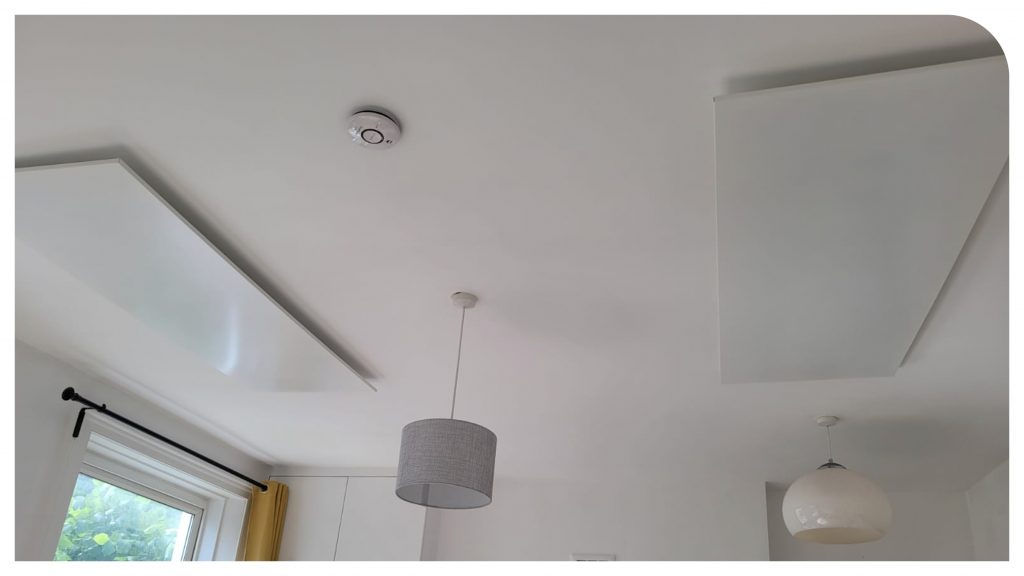We’ve been brought up on convection heating and we’ve been conditioned that electric heating (all electric heating) is bad and expensive. It’s not.
Convection heat and infrared heat are much different. It’s important to understand the difference. Click here to brush up on What is the difference between convection and infrared heat?
One of the biggest mis-conceptions about heating is that heat rises. It doesn’t. Warm air rises. Convection heating heats the air, which is where this misunderstanding comes from. Infrared heating heats people and objects directly. The people and objects heated by infrared will in turn heat the air.
When we heat a space using convection heat, that space is heated from the top down due to convection air flow. This is the reason why we’ve been conditioned to turn convection heating on and off regularly. Convection heat is really inefficient and really expensive to run. Now as if that’s not enough, convection heating can also be uncomfortable due to an uneven temperature between floor and the ceiling. Hot heads and cold feet anyone?
Infrared heats just like the sun. Heating directly, no need to wait for the whole volume of air or stand in the sun on a sunny, cold, winter’s day. That’s infrared heating. So, infrared heats objects and people first, these objects (we’ll include people as an object) then radiate infrared heat back out, like ripples in water. The end result is a space with the same air temperature as a convection heated space. The difference, you feel the heat sooner and it’s all done much more efficiently.

Can Infrared Heaters Run All The Time?
If infrared heating works in a more efficient way than convection heat we don’t need to worry about turning it on and off all the time like convection heating. Right?
Infrared heating stores heat in the structure of the space, actually if installed and specified correctly it is more efficient to leave it switched on.
To clarify, the most efficient way to set up an infrared heater is by using temperature parameters. Infrared heaters should be set up with an ‘on’ temperature, that is the temperature you want your home or office to be at when you are there and using it.
There should also be an ‘off’ temperature, that is a temperature that you do not allow the home or office to drop below. Typically the ‘on’ temperature would be 20ºC or 21ºC with the ‘off’ set at 14ºC or 15ºC.
When set up to operate this way, an infrared heating system benefits from the following:
- Less heat loss
- A more comfortable heat
- Great efficiency
A well manufactured and efficient infrared heater will maintain both the ‘on’ and ‘off’ temperatures efficiently and will generally only be drawing power (and not full power) about 1/3 of the time.
Can infrared heaters run all the time? Yes, and if you want an efficient heating system then this is the best way to set them up.
Curious about Jigsaw infrared heating
To be sure that infrared heating is right for you. Why not read our studies from the European Union Regional Development Fund (ERDF).
Click here to read a study on how sustainable infrared heating panels really are?
Click here to read a study on a cross comparative analysis of convection heating, infrared heating panels, and Air source heat pumps.
Learn more about our British Manufactured and Certified Infrared Heaters
View the Range
Or, get more information from one of our specialists by filling in the form below.



3 Comments. Leave new
This is excellent and useful information presented well. Much appreciated. Planning to switch to infrared heating as a result. Thanks!
I have wall/ceiling-mounted radiant heating panels in every room in my home. They were all installed when the home was built in 1981, 40 years ago. Should I be concerned about the safety of these units? They seem to be working fine with the exception of one unit will make a loud pop noise when it’s first turned on in a cold room. Is this normal or should I have it looked at by a professional HVAC person?
It could be the expansion of the metal causing the loud pop noise. If you are unsure then we would recommend having them looked at by an electrician.